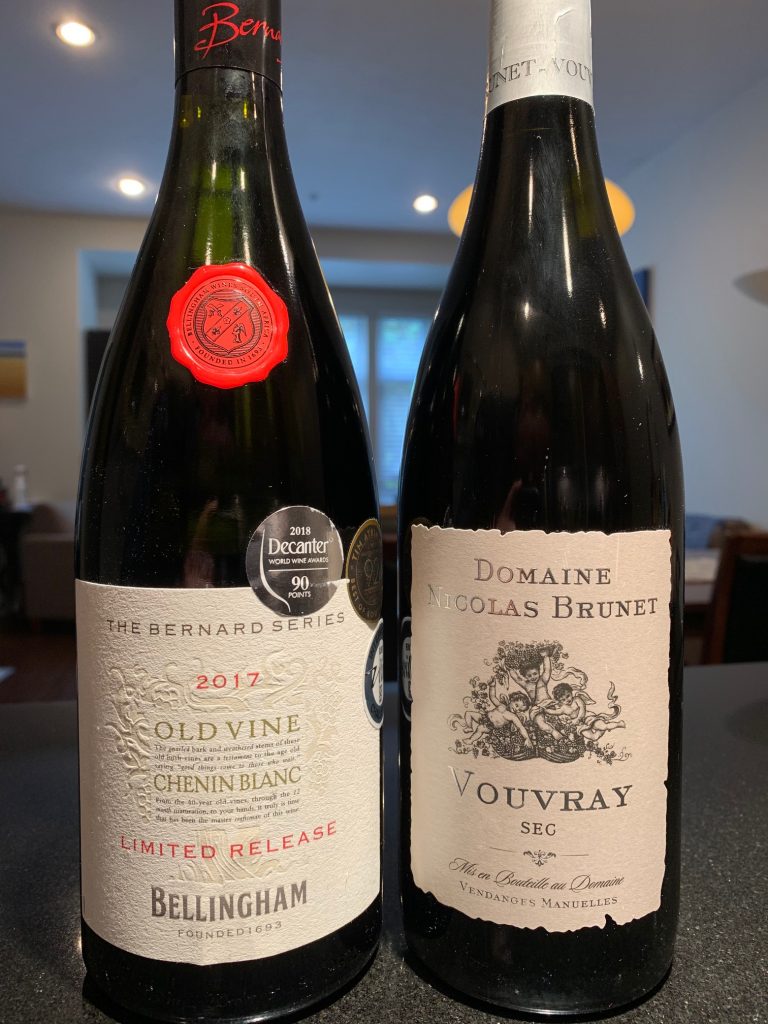
Two great yet utterly different Chenin Blancs
Earlier this week, I kicked off my new online wine tasting course here at Wine Fundamentals. And yes, this brand name is apt: it was both ‘fun’ and ‘mental’ – enjoyable and mentally challenging at the same time.
The online course runs over three nights, and features two different wines made from the same grape variety each night. The aim being to compare and contrast wines with a common denominator, thus building up your memory bank for any given wine variety and/or style. The other decision I made in selecting the wines was, for each pair, to select a classic French example alongside a wine from the so-called New World. My thinking was that the French wines might serve as a traditional benchmark against which to compare/contrast the wines from elsewhere.
For our first session, we tasted two Chenin Blancs: the same white grape variety, but two different styles, one from France and the other from South Africa.
First up was the Bellingham Bernard Series Old Vine Chenin Blanc 2017 from South Africa. This wine was made from grapes harvested off three old vineyard blocks across the Western Cape, with an average age of around 40 years. The Cape has some of the world’s oldest Chenin Blanc vines, and has been making these wines, previously called Steen, for ages. However much of this was mediocre at best, and most Chenin grapes went to local cooperatives for blending into innocuous, simple white wines, or were used for distilling into brandy.
In recent years, the Cape has rediscovered its Chenin Blanc heritage and is now making some of the world’s most distinctive, complex Chenin wines. The Bernard Series is a great example: Rich, ripe-fruited, with real weight, full-bodied and a creamy texture, in part from fermentation and aging in new and second fill oak barrels for 12 months. The wine showed very well, offering a complex range of tropical and tangy fruit aromas and flavours, along with rich cashew nuttiness, toast and quince on the palate, and a long, layered finish underpinned by good acidity.
Our second wine was Domaine Nicolas Brunet Vouvray Sec 2014. Vouvray is one of the foremost appellations in the central Loire Valley for Chenin Blanc, although, this being France with its AOP regulations, they can’t name the grape on the label of course. The back label small print gives it away though, and also mentions that this is a Sec Tendre, which is the coy French term for off-dry. This wine too was made from grapes off an old vineyard, at least 45 years old. The result is increased intensity and complexity, and a strong sense of place in the wine.
The wine was a deep gold colour. Complex, layered aromas of dusty chalk, honey, toasted pastry, quince, green apple and pear unfurled from the glass. The palate offered up more of the same, along with nuttiness and a definite hint of sweet ripe apricot, from the small portion of botrytis-infected grapes that likely went into this off-dry wine. The sweetness was beautifully balanced though by piercing, clean acidity, the hallmark of great Chenin. The finish was long, layered and complex. Delicious!
So there you have it: Two Chenin Blanc wines, both terrific, and yet so very different. This tasting highlighted the fascinating diversity of wine styles that the Chenin Blanc grape can produce, and also the influence of terroir and the hand of man. A wonderful experience. If you’d like to participate in future online tasting courses, send me an email at urbanforum@shaw.ca